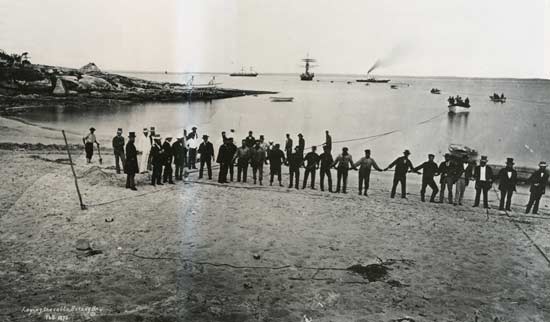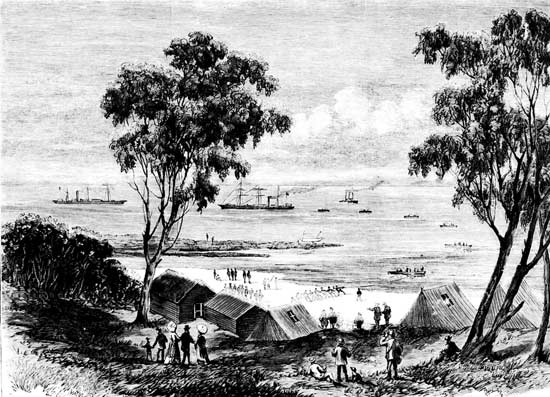The route was La Perouse (Botany Bay), Sydney, Australia, to Wakapuaka, Nelson, New Zealand. The cable was made and laid by Telcon for the Eastern Extension Australia & China Telegraph Co. using CS Hibernia and CS Edinburgh.
System length 1283 nm. HMS Challenger surveyed the route. The Sydney end of the cable was diverted into Bondi Beach in 1917. Withdrawn from service in 1932.
John Seymour was First Mate on CS Hibernia for this expedition.
Illustrated London News: Volume LXVII, page 323 (1875)
The Telegraph Construction and Maintenance Company is rapidly performing its task of making the submarine cable to be laid down between Sydney, New South Wales, and Nelson, New Zealand, a distance of nearly twelve hundred miles. This line, its construction, and its future working, was undertaken five months ago by the Eastern Extension Telegraph Company, making an agreement for that purpose with Sir Julius Vogel, Prime Minister of New Zealand, jointly with a representative of the New South Wales Government, which latter province bears one third of the guaranteed yearly interest upon the whole cost.
Sir Julius Vogel, accompanied by several other gentlemen, visited the works of the Telegraph Construction and Maintenance Company at East Greenwich, on Wednesday afternoon. He was received by Admiral Richards, a director of that company, Mr. Clifford, engineer in charge of the works, Mr. Shuter, and others. He minutely inspected every process of the manufacture, which is in a most satisfactory state.
The steam-ships Edinburgh, and Hibernia, belonging to the company, are to be employed in carrying out and laying the cable, under the command of Captains Manning and Cato. The Edinburgh, now lying off the company’s wharf at East Greenwich, has received her load, consisting mostly of the heavy shore ends, and will probably leave the Thames on Monday next. The Hibernia, of 3200 tons burden, will convey a thousand-miles’ length of the deep-sea cable, which is of slighter make than the shore ends.
It is hoped that both vessels will reach Australia early in December; and that in January or February, the best summer months of that region, the telegraph will be successfully completed. There is already a complete system of land telegraphs all over both the principal islands of New Zealand.

Laying the cable, Botany Bay, Feb 1876
A discussion of this image may be read here |
Australian Town and Country Journal (Sydney).
Saturday 12 February 1876
Submarine Cable from New South Wales to New Zealand.
An event of the highest importance, in respect to the interests of intercolonial commerce, viz., the laying of the shore end of the cable, just below La Perouse monument, Botany Bay, New South Wales, to connect with Blind Bay, Nelson, and thence with the land lines of New Zealand, took place on Saturday morning.
The spot chosen for the laying of the shore end of the cable possesses some historical interest. It is situated on the north side of Botany Bay, just within the entrance, directly opposite the place on the south side of the bay where Captain Cook landed in April, 1770. A few days after the arrival of Captain Phillip and the first fleet January 18th, 1788, the celebrated French navigator, M. La Peyrouse, with two ships bearing French colour, entered the bay, having left Brest in August, 1785, and had during their voyage made some important discoveries. La Peyrouse established himself at this spot, in Botany Bay, for the purpose of completing two boats, which he had brought out in frame. An observatory sent, was also put up for the convenience of Monsieur D'Ajelet, the chief astronomer of the expedition. During the stay of the French ships the naturalist of the expedition, Father Le Receveur, died from the effects of wounds received in a conflict with the natives at the Navigators Islands. A monument, with a suitable inscription, was erected to his memory. La Peyrouse sailed out of Botany Bay with his vessels, Astrolabe and Boussole, on the 10th March, 1788. Nothing definite was heard of La Peyrouse till the year 1826, when Captain Peter Dillon obtained information that the two vessels were wrecked on Mallicolo, one of the New Hebrides, and that the crew of one vessel had all been murdered or drowned, and that some of the crew of the other had built a boat and sailed away. Previous to the discovery of the articles belonging to the ship on the island, the French Government caused to be erected on the spot where La Peyrouse had parted from his English friends a monument—in the shape a picturesque lofty stone column—to his memory.
The proceedings in laying the cable were exceedingly interesting. The cable steam-ship, Hibernia, Captain Cato, and the Edinburgh cable steam-ship, Captain Manning, left Port Jackson on Friday afternoon, and anchored in Botany at 5 p.m.
For some time past the officers connected with the expedition have been making the necessary preparations. Four tents and two weatherboard buildings, on stone foundations, for the accommodation of the cable offices, have been constructed immediately below the monument and thirty-five yards from the shores of the bay. In the principal of those weatherboard buildings, which is only 12 feet square, all the instruments are erected. There are four of Sir William Thompson’s aesthetic mirror galvanometers, in addition to a speaking galvanometer, and one of Morse’s spare instruments.
At 6 a.m. the boats made ready, from the Hibernia, which was anchored one-third of a mile off. A great length of cable rope was stretched from the ship to the main land, 100 yards east of the place where the cable was to be landed. The life-boat, with the first portion of the cable on board followed, and the cable looped from seven other boats, was carried to the shore. When sufficiently far to the east, the main boat swerved back, and by this means abundance of slack cable was secured to reach into the operating room. The life boat, with the cable, was manned by a strong crew, who enlivened the proceedings by chanting sea-songs. The attendance of spectators was not numerous. Among those present were noticed the officers, engineers, and electricians of the ship, Mr. Dickinson (Learmonth, Dickinson, and Co., the agents of the cable vessels), Mr. John Rae, Mr. E. C. Cracknell, Mr. F. W. Hill, Mr. Phillip B. Walker, Mr. Wilson, Mr. Dalgarno, Mr. Wise, Mr. W. Hill, Mr. Peck, Mr. O’Sullivan, Captain McDermott, and Mr. Skarrat. When the first boat was brought with a heavy rope attached to the cable, the whole of the spectators cheerfully rendered assistance to the officers and crew, and dragged the life-boat in.
At 7.30 a.m., the cable end was landed, and in twenty minutes afterwards connection was established. In two minutes after connection a remarkable feat was accomplished. As before explained, the cable is laid on the Hibernia in three large tanks, each containing over four hundred miles of wire. Each tank is connected, and a message was received at the station from the ship saying, “All right,” or “O.K,” the message having traversed the whole length of the wire which, if stretched, would reach to New Zealand. This piece of intelligence was highly satisfactory. In about an hour afterwards (ten minutes past 9 a.m.) the Hibernia began to steam slowly away, accompanied for a short distance by the Ajax and Mystery, and at 9.30 she passed through the Heads on her way to New Zealand, paying out the line without the slightest hitch. Shortly afterwards the Edinburgh started.
Several other tests were taken, and proved that communication was perfect, when the Hibernia got out to sea.
In addition to the information already furnished, it will be interesting to know that the total length of the line will be about 1370 nautical miles. The cable will be of the following types or sizes, measuring from La Perouse, N.S.W., to Blind Bay, viz.:–
| Type |
A-Shore end |
5 |
nautical miles |
| " |
B-Intermediate |
15 |
" |
| " |
D-Second ditto. |
148 |
" |
| " |
C-Deep Sea |
1001 |
" |
| " |
D-Second intermediate |
152 |
" |
| " |
B-Intermediate |
44 |
" |
| " |
A-Shore end |
5 |
" |
| |
|
1370 |
" |
The weight of type A is 12 tons per mile; of type B, 4 tons per mile; of type D, 2 tons per mile; type C, 1¼ tons per mile.
As before explained, the original cable contractors are the Eastern Extension Australasian China Telegraph Company (Limited). The sub-contractors for the manufacture and laying the telegraphic cable are the Telegraphic Construction and Maintenance Company (Limited), whose engineer is Mr. F.H. Lucas, who has charge of the expedition, Mr. J.C. Laws being chief electrician. The engineering and electrical staff of assistants number ten. The electrical work on shore during the laying is under the charge of Mr. Thomas Brown assisted by Messrs. E.A. Stevenson, W. Downing, J. Pinkerton, H. Kingsford, W. Redgrave, and T.A. Clark. When the cable is laid and tested to the satisfaction of the Eastern Extension Australasian and China Telegraphic Company, who are represented on board the ship by Messrs. Charles Hockin, Peake, and Archdale, it will be handed over to that company, and will then be opened for traffic under the management of their superintendent, Mr. W. Grigor Taylor, who will have two able assistants, Mr. C.J. Davidson and J. Lockley, and will be permanently stationed at La Perouse. In terms of the contract the Edinburgh will be permanently stationed on the Australian station to keep the cable in repair.
For much of the above information we arc indebted to Mr. Grigor Taylor, whose courtesy we feel bound to acknowledge.
A news report in the Illustrated Sydney News and New South Wales Agriculturalist and Grazier issue of 3 March 1876 describes the successful completion of the cable, and includes this view of the cable being landed at Botany Bay:

Landing the New Zealand Telegraph Cable at Botany Bay |
The submarine cable between New Zealand and New
South Wales has been successfully laid, and the former
colony is henceforth brought into immediate connection, not
only with its sister states in the South Pacific, but with the
entire civilised world. The work has been projected,
planned, and completed within a very few months; and to
the present government of New South Wales is due the
credit of resuming the dropped negotiations and carrying
the entire enterprise through without delay. The cable is
supplied and worked by the Eastern Extension Australasia and China Telegraph Company, which receives a subsidy of
£7500 per annum for ten years; one third from New South
Wales and two thirds from New Zealand. This sum is practically a present to the company, which has undertaken the responsibility of making and maintaining the communication, as neither colony has anything to do with the management or the receipts of the line. The manufacture of the cable was entrusted to the Telegraph Construction and Maintenance Company, under whose supervision it was laid, but their control of it and connection with it ceased on Saturday, February 19th—the moment that the laying was accomplished and the cable tested.
|

